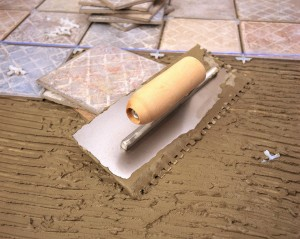Someone in San Miguel asked about setting tile:
There are a few basic rules but the subsurface needs to be evaluated. If you have cracks in the cement floor/subsurface they should be “bridged” or patched with an anti-fracture membrane perhaps reinforced with mesh. These membranes are flexible and absorb some of the movement that caused the crack and can minimize or lessen the transfer of the crack up through the finish tile. In the U.S. we often use “expanded metal lath” which is harder to find here. This is nailed down to the base and a first layer of thin set is put down to form and completely new base on which you use more thin set and then tile. This could be “overkill” for your conditions.
Next the concrete base must be really clean and free from debris, dust and especially grease and oil. For most residential applications a professional tile setter will level the surface with a first coat of a multipurpose “thin set mortar” in the low areas then continue with the tile setting job with more thin set that is designed for your application (indoor?outdoor?what kind of tile etc). It is sticky because it can be used over plywood, cement etc. It will probably be portland cement based and have latex and other additives that fortify it and give it adhesive quality. The tile stores here sell decent products.
TIP: Some tile setters don’t dampen the bottom of the tile before installation and if it is porous tile, it sucks the moisture out of the thin set so fast that the adhesion and strength of the setting compound is adversely affected. The thin set will harden too quickly and not bond. Dense, high fire, machine-made tile doesn’t need much moisture if any.
There are other methods such as chipping little notches in the base material (cement or mortar) so that the next application of plaster or cement or in the case of tile, the setting compound/thin set will bond better because it “keys” into the base (a standard practice here). If you want to know how effective this is, just watch how easily the plaster comes off the wall when it is chipped off an aging wall to prepare it for a new coat of plaster. Often it isn’t well bonded. This could be more due to a dirty dusty surface than lack of bonding from the notches.
Good luck with your new floor, Ron
